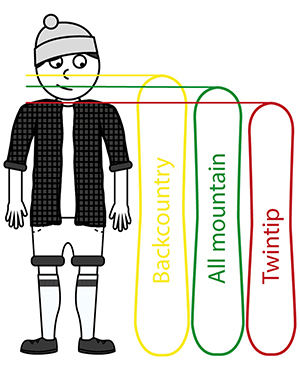Purchasing Snowboards
Your snowboard selection is heavily influenced by your skill level and your enthusiasm for riding on the piste, in the park, or in the off-piste areas. It is also essential to take into account your foot size, weight, and height.
How to Choose the Correct Length and Width of Snowboard?
- Snowboard Length is dictated by your preferred terrain and your height. Generally, the board should reach between your shoulders and the middle of your head. Longer boards are typically advised for backcountry/off-piste, while shorter ones are better for freestyle. A medium-length board is adaptable for all-mountain riding.
For beginners and children, a slightly shorter board is often recommended for a straightforward and enjoyable snowboarding experience. Size guides, when available, are provided on the specific snowboard product pages.
Recently, brands have started offering model-specific size charts based on weight, which might be the optimal approach for selecting the right snowboard length. - Snowboard Width is primarily categorized as Standard or Wide. Wide boards are suggested for those with a shoe size of 44 and above, excepting junior wide boards.

Different Categories of Snowboards
- Twintip snowboards are perfect for park tricks but also enjoyable on the piste. These boards have an identical front and back, and the bindings are centrally positioned, which facilitates riding and landing tricks in both directions.
- All Mountain snowboards are incredibly versatile. Their shape mirrors a twintip snowboard, but the bindings, flex, and balance point are set back on the board. This type of snowboard is an excellent choice for most users since it performs well on the piste, in the park, and off-piste.
- Backcountry: Crafted for deep powder in off-piste areas, backcountry snowboards resemble surfboards in shape. Their large surface area offers exceptional flow in deep snow conditions.
Snowboard Construction Styles
Shape
- Directional: Designed primarily for travel in one direction, usually on the piste or off-piste. This shape includes a stiffer construction at the tail for enhanced stability at high speeds.
- Twin: Features a symmetrical front and back, making it ideal for tricks and park rides. Twin-shaped snowboards can move effectively in either direction.
- Directional Twin: Combines elements of both shape types and is often crafted for all-mountain and freestyle snowboards.
Baseline Design
The baseline (bottom of a snowboard) varies, featuring camber, rocker, or flat designs. Often, these are combined according to the snowboard's intended use.

- Rocker: Occurs when the snowboard curves upward at the tip and/or tail, making it ideal for powder snow and easy manoeuvres. The rocker design reduces friction, making it reliable in park settings.
- Camber: With this design, the nose and tail press deeply into the snow, widening contact with the snow and improving edge grip.
- Flat: Ensures full contact with the snow, providing more stability than a traditional rocker, with easy manoeuvrability.
